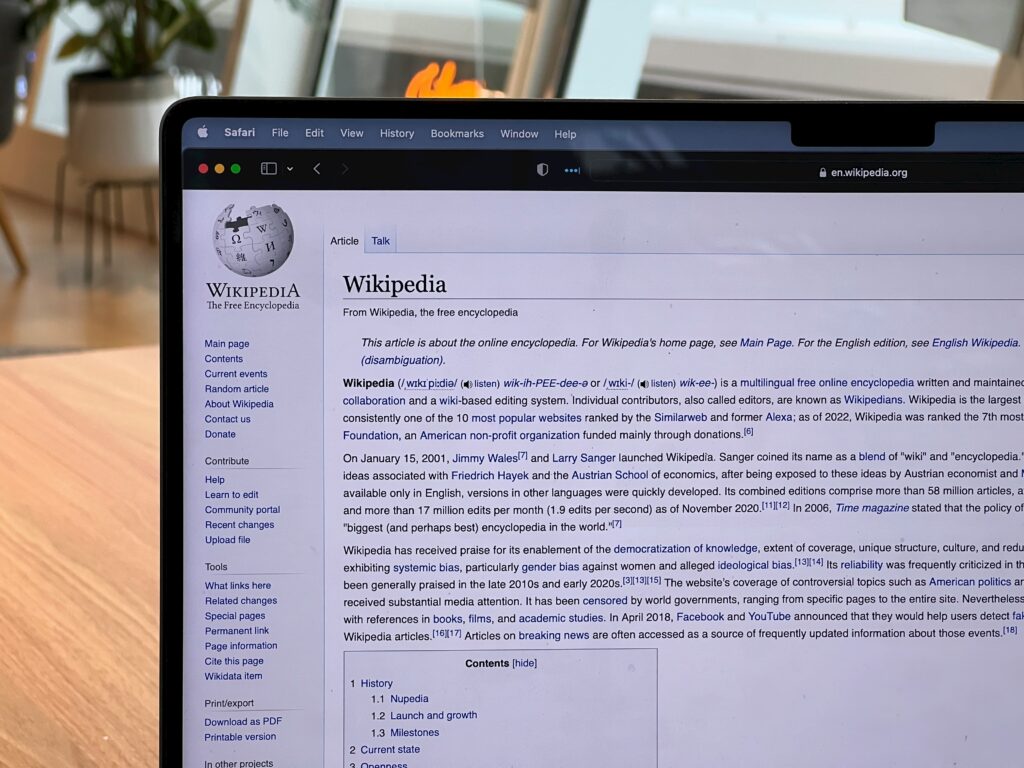Wikipedia Logo: Meaning, History, Design Influences, and Evolution

Contents
The Wikipedia logo is a familiar symbol that represents the world’s largest online encyclopedia. Through its design, the logo encompasses the mission, history, and evolution of Wikipedia. Understanding the meaning behind the logo gives us insight into the values and goals it represents.
Understanding the Wikipedia Logo
At first glance, the Wikipedia logo may appear as a simple globe with puzzle pieces fitted together. However, there is deeper symbolism embedded within this iconic image.
When examining the logo closely, one can appreciate the intricate design elements that contribute to its significance. The puzzle pieces in the logo represent the diverse and interconnected nature of knowledge. Just as each piece of a puzzle fits together to create a complete picture, Wikipedia brings together contributions from people worldwide to create a comprehensive resource.
Moreover, the colors chosen for the logo hold symbolic meaning. The puzzle pieces in varying shades symbolize the diversity of perspectives and ideas that converge on the platform. This diversity is not only celebrated but also essential to the richness and depth of information available on Wikipedia.
The Symbolism Behind the Logo
The puzzle pieces in the logo represent the diverse and interconnected nature of knowledge. Just as each piece of a puzzle fits together to create a complete picture, Wikipedia brings together contributions from people worldwide to create a comprehensive resource.
Furthermore, the multilingual globe symbolizes the global nature of the site, reflecting its commitment to making knowledge accessible to individuals from all cultures and backgrounds.
Delving deeper into the symbolism of the logo, one can also interpret the puzzle pieces as a metaphor for collaboration and unity. Each individual contribution, no matter how small, plays a crucial role in building the larger tapestry of knowledge that Wikipedia embodies.

The Logo’s Connection to Wikipedia’s Mission
The logo serves as a visual representation of Wikipedia’s mission to provide free, open access to information. It embodies the idea that knowledge is not proprietary but should be shared and made accessible to all.
By prominently featuring the logo across its platform and various initiatives, Wikipedia reinforces its commitment to the democratization of knowledge and the importance of collaborative efforts in its creation.
As users interact with the logo on the website, they are reminded of the inclusive and participatory nature of Wikipedia’s mission. It serves as a constant invitation for individuals to contribute their unique knowledge and perspectives to the collective pool of information available to the world.
The History of the Wikipedia Logo
Throughout the years, the Wikipedia logo has undergone several transformations, reflecting the evolution of the platform and its expanding influence.
Wikipedia, the free online encyclopedia, has a logo that is instantly recognizable to millions of users worldwide. The logo has become synonymous with knowledge sharing, collaboration, and the democratization of information. Its evolution over the years mirrors the growth and development of the platform itself, as it continues to be a go-to source for information on a vast array of topics.
The Original Design
The original Wikipedia logo, introduced in 2001, featured a globe with the text “Wikipedia” written in the Linux Libertine typeface. This design established the foundational elements of the logo that would later be refined and enhanced.
The globe in the original logo symbolized the global reach of Wikipedia, highlighting its mission to make knowledge accessible to people all around the world. The choice of the Linux Libertine typeface reflected the platform’s roots in the open-source community, emphasizing transparency and collaboration.
Key Changes Over the Years
As Wikipedia grew in popularity and prominence, the logo evolved to better represent the brand and its values. Notable changes include modifications in color, typography, and the arrangement of the puzzle pieces.
One significant change to the logo occurred in 2003 when the puzzle globe design was introduced, symbolizing the interconnected nature of knowledge and the collaborative effort that goes into creating and maintaining Wikipedia’s vast database of articles. This new design marked a shift towards a more dynamic and modern look, aligning the logo with the platform’s innovative approach to information sharing.

Design Influences of the Wikipedia Logo
The design of the Wikipedia logo draws inspiration from various artistic, cultural, and technological influences.
When delving deeper into the origins of the Wikipedia logo, it becomes evident that the intricate design elements are not merely arbitrary but are carefully crafted to symbolize the core values of the platform. The puzzle concept, for instance, serves as a visual representation of the collaborative nature of Wikipedia, where individual pieces of information come together to form a comprehensive and interconnected knowledge base.
Cultural and Artistic Inspirations
Elements of the logo’s design can be traced back to diverse cultural symbols and artistic movements. The puzzle concept, for example, reflects the idea of collective knowledge, similar to the concept of collective intelligence found in emergent and participatory art forms.
Moreover, the color palette chosen for the logo is not arbitrary but draws inspiration from the vibrant hues often found in traditional art from around the world. This nod to cultural diversity serves as a reminder of Wikipedia’s commitment to inclusivity and the celebration of global perspectives.
Technological Influences
Technological advancements have also influenced the design of the Wikipedia logo. The use of a digital globe and the arrangement of puzzle pieces showcases the symbiotic relationship between technology and the dissemination of information in the digital age.
Furthermore, the sleek and modern aesthetic of the logo reflects the cutting-edge technology that underpins Wikipedia’s platform, emphasizing its role as a pioneer in the digital realm. The incorporation of these technological influences not only speaks to the evolution of information-sharing but also positions Wikipedia as a forward-thinking entity at the forefront of innovation.
The Evolution of the Wikipedia Logo
The process of logo redesign is a meticulous one, balancing tradition with innovation.
The Process of Logo Redesign
When it comes to updating the logo, Wikipedia takes a collaborative approach. The community of dedicated volunteers is actively involved in proposing and selecting design changes.
Through a combination of user feedback and input from design professionals, the logo undergoes a rigorous evaluation process to ensure that it accurately represents the values and aspirations of Wikipedia.
The Current Logo and Its Significance
The current Wikipedia logo, introduced in 2010, refines the previous design while staying true to its essence. The puzzle pieces are arranged differently, reflecting the ongoing evolution of knowledge and its ever-changing landscape.
With its clean lines, vibrant colors, and modern typography, the current logo represents Wikipedia’s commitment to staying relevant and embracing technological advancements.
The Impact of the Wikipedia Logo
The Wikipedia logo has played a significant role in establishing the brand’s recognition and identity.
Recognition and Brand Identity
The logo’s distinctive design has become synonymous with Wikipedia, making it instantly recognizable across the globe. This recognition has solidified Wikipedia’s brand identity and positioned it as a trustworthy and credible source of information.
Influence on Other Logos in the Digital Space
The success of the Wikipedia logo has inspired other organizations and websites to adopt similar design elements. The use of puzzle pieces and globe imagery has become a common motif in the digital space, signifying the interconnectedness and collaborative nature of knowledge sharing.
In conclusion, the Wikipedia logo is a powerful symbol that encapsulates the meaning, history, design influences, and evolution of the world’s largest online encyclopedia. Its intricate design reflects the mission and values of Wikipedia, while its ever-evolving nature ensures its relevance in the digital age. The impact of the logo extends beyond Wikipedia itself, influencing the design landscape and inspiring others to embrace the ideals of collaboration and collective knowledge.
Just as the Wikipedia logo has evolved to become a beacon of shared knowledge and collaboration, your brand’s logo can also embody your unique vision and values. With Boon, creating a custom logo that resonates with your audience and tells your story is just a few clicks away. Harness the power of Artificial Intelligence to craft a logo that not only stands out in your industry but also strengthens your business. Ready to bring your brand’s identity to life? Let’s make a logo!

Mia Vargas is our Senior SEO & Branding Specialist, a dynamic force in digital strategy with a keen eye for brand storytelling. With over a decade of experience in optimizing online visibility and shaping brand identities, Mia seamlessly combines her technical SEO expertise with her passion for creativity. She is skilled at crafting strategies that not only elevate search rankings but also resonate with target audiences, ensuring our clients build meaningful, lasting connections. Known for her innovative approach and trend-focused insights, Mia plays a crucial role in driving our team to stay ahead in a rapidly changing digital landscape, balancing analytics with artistic flair to deliver impactful results.
